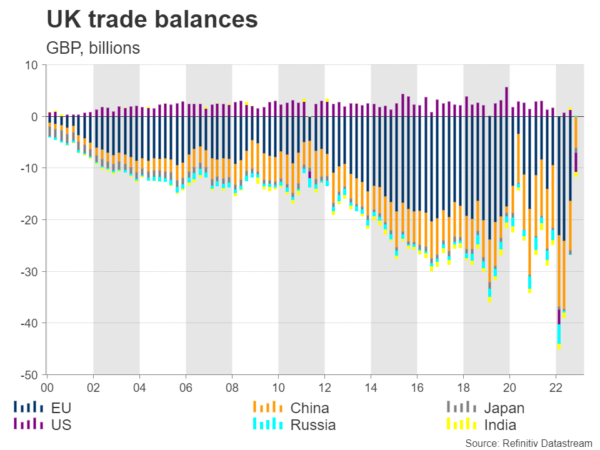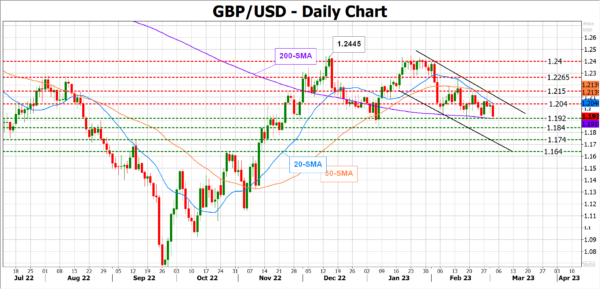Rishi Sunak is making his first Brexit debut in efforts to resolve the long-running dispute with the EU over trade rules in Northern Ireland. While hopes for a new breakthrough pushed the British pound in the green territory this week, the reaction was relatively modest, suggesting that investors are being prudent by waiting for more clarity to drive the currency higher. Yet, the uncertain global economic and geopolitical risks could make the opposition compromise, suggesting that Sunak has likely chosen the right moment to resolve the Brexit rift.
What’s the new deal?
It’s time for the new UK prime minister Rishi Sunak to test his Brexit tactics following an almost seven-year-old war of words with the EU, which has successfully led to the withdrawal from the union but practically left the UK economy with unworkable customs controls at the Britain-Irish border. Like his predecessors, Sunak will have to sail through the waves too. Perhaps a new backlash from Tories cannot be ruled out if his 100-page proposed revisions to the problematic Northern Ireland protocol, known as the Windsor framework, gets rejected at home despite the approval from the European Commission.
The plan aims to simplify border checks by splitting the goods transferred from Britain to Northern Ireland into two different lanes and authorizing trusted traders; green for those staying in Northern Ireland with drastically simpler requirements and no physical routine checks, and red for those heading to the Republic of Ireland facing custom checks and other processes.
The agreement also provides flexibility to the UK to apply VAT rates below the EU VAT minimum rate for immovable goods and use the UK SME VAT exemption scheme subject to the EU threshold for the size of small-medium enterprises (SMEs).
More importantly, under the most exceptional circumstances, the UK will be allowed to trigger the emergency mechanism called the “Stormont brake” at the request of 30 members of the legislative assembly in Northern Ireland to stop the plan if it observes a lasting negative impact on the community.
Last but not least, the deal has revived hopes for the UK to rejoin the EU’s 95.5bln euro Horizon research program as uncertainty over the EU-UK trade relations has hammered business investment.
Sticking points
While the above arrangements received an immediate positive comment from Brexiteers, with former Cabinet minister David Davis saying that rebellion could calm among Tories, that is a story investors have heard before. The Brexit history has a rich track of unsuccessful rounds of debates and amendments and investors will probably need to see actual progress before they become confident that Sunak’s proposal is the right one.
In the meantime, the ball is in Northern Ireland’s Democratic Unionist Party’s court, which keeps boycotting the government over the persisting EU regulations on the Irish border. Although the party’s leader Jeffrey Donaldson offered some warm words for the plan, he also argued that it may not be enough to persuade his party to back down from its red lines, while he refused to say when the behind-the-scenes talks will conclude.
The truth is that the DUP’s demand for no EU laws at the borders may remain unacceptable. The EU will maintain robust authorization and monitoring of Trusted Trader and Authorized Carrier schemes while applying some rules in specific areas according to the agreement.
Is it the right time for a Brexit fight?
Hence, finding a middle solution might be a tough task for the new government but not impossible as a trade deal with the EU would be valuable during a challenging period for the UK economy. With high inflation eating into consumers’ pockets, soaring government debt allowing limited room for fiscal stimulus, and a trade deficit at multi-year highs, there is little to show for the benefits of Brexit.
The British pound could regain some lost confidence from buyers if the DUP does not create drama over the new UK-EU deal. The opposition Labor party, which is currently leading the polls by 48% compared to Conservatives’ 26%, has shown no interest to snipe either but support the plan if it’s implemented in benefit of the Good Friday Agreement.
Hence, given the relatively calmer political opposition at home and the worsening geopolitical risks in Ukraine, Sunak may have better luck in making everyone accept a not so perfect EU-UK trade deal. Until further notice, the focus will remain on the Bank of England, with a barrage of data and speeches from central bankers likely questioning the pace of rate hikes in the coming weeks. Analysts are certain that the BoE will downshift to a 25bps rate hike on March 23 and chief Andrew Bailey has somewhat embraced the case lately, citing households’ financial difficulties ahead of the UK budget announcement on March 15.
GBPUSD
Should the data disappoint, suggesting that a rate peak could come sooner rather than later, GBPUSD may slide below the 200-day simple moving average (SMA) at 1.1920 to test January’s low of 1.1840. A step lower would signal a bearish trend reversal, bringing the 1.1740 support region next into view ahead of the 1.1640 barrier.
Alternatively, upbeat readings could back expectations for a higher rate peak, sending the pair above the constraining 20-day SMA at 1.2040. The 50-day SMA and the 1.2150 resistance could be the next challenge. If the bulls knock down that wall, the recovery could extend up to 1.2265 and then towards the 1.2400 zone.
A surprise DUP approval of the Windsor agreement could add more fuel to the rally.















